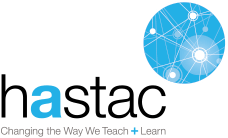by Nathan Loewen, Department of Religious Studies
The 2017 HASTAC conference was nothing short of amazing, in my humble opinion. The acronym stands for Humanities, Arts, Science, and Technology Alliance and Collaboratory, which is based on the proposal that “today’s new, global forms of communication and online learning are so complex and potentially so revolutionary that they demand a new alliance of humanists, artists, social scientists, natural scientists, and engineers, working collaboratively.” I was able to attend this event thanks to the generous support of a travel grant provided by Instructional Technology and Academic Services. Faculty who are developing online courses or teaching online at Bama by Distance degree programs may be eligible for these kinds of opportunities.
While the theme was “The Possible Worlds of Digital Humanities,” the contents of the event were anything but a theodicy of digital scholarship as the best of all learning online. Instead, the events at HASTAC repeatedly demonstrated how applications of humanist skepticism to technology may promote excellence in digital teaching, learning and scholarship. As HASTAC co-founder Cathy Davidson writes, this results in considering how to “think like Einstein.”
I deeply appreciated what happened at HASTAC: scholars gave open-ended presentations of a research question, their methods and the challenges encountered in doing their work. The other scholars in the room then set about constructively taking the work further through digital media platforms that recorded and extended the collaborations in real time. I left these sessions with reams of new knowledge, questions and resources.
A preliminary overview of most sessions was provided with a personal touch through “Hack the Abstract.” Much of the session content was made publicly available online. A review of the #HASTAC17 on Twitter shows how to access much of this open, collaborative scholarship.
The atmosphere of the conference could be summarized as focused on collaboration and openness. This translated into a widely-shared skepticism about technology and online platforms. These tools should not be used uncritically. Instead, the very structures of digital tools should be interrogated for their implicit biases. As such, the general expectation was that rigorous academic scholarship and teaching should always present and answer these questions. Put otherwise, scholarship and teaching should consider how to control technologies as variables that influence research and learning outcomes.
I plan to write several posts about the event:
- Highlights of the keynote sessions.
- Application of what I learned to teaching and learning online.
- Discussion of particular sessions related to research for digital scholarship.
Stay posted!
